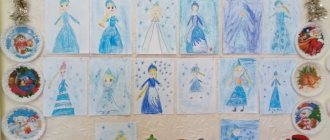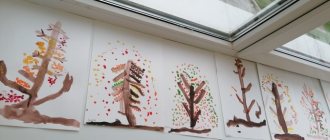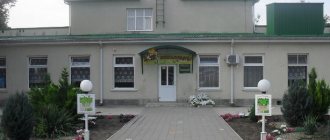MAGAZINE Preschooler.RF
Summary of GCD in the senior group. Theme "Flowers".Author: Sivoldaeva Irina Vasilievna
Educational "Communication" .
Form of delivery: “Cognitive lesson”
Integration of areas:
“Communication” (main educational area), “Cognition” , “Socialization” , “Physical Education” , “Music” .
Types of activities: communicative, gaming, motor.
Tasks:
Correctional and educational:
- Clarify the idea of flowers, their parts, and where they grow.
- Enrich your vocabulary with new nouns, adjectives and verbs.
- Exercise children in forming the plural of words.
- Practice forming diminutive forms of nouns.
Correctional and developmental:
- Develop visual perception, logical thinking, auditory attention.
- Develop fine and gross motor skills.
- Develop speech breathing.
- Develop attention and the ability to answer questions clearly and competently.
Correctional and educational:
- To cultivate love and respect for flowers and nature:
- Foster respect for work.
Equipment: multimedia projector, multi-colored clothespins and a colored circle, a picture with lilies of the valley according to the number of children, artificial flowers according to the number of children.
1. Organizational moment. Emotional mood for the lesson.
Speech therapist: - Guys, look at me. I will try to determine from your faces what mood you are in today. I see that for the majority it is good and cheerful. I'm also in a cheerful mood today. Let's pass on our cheerful mood to each other. Look at the person standing next to you, smile at him and mentally wish him something good.
2. Report the topic of the lesson. Updating knowledge on the topic.
Game "Say the Word" .
The speech therapist reads the riddles, the children add the last word in chorus (slide No. 2).
Flowers - a basket with a yellow center, a white shirt. Good... (chamomile).
A beautiful flower hid in the petals, like in a satin cloak. It won’t open up in any way In the garden there is a red one... (poppy).
A wonderful flower, Like a bright light, Lush, important like a gentleman, Delicate, velvety... (tulip).
Eh, bells, blue, with a tongue, but there’s no ringing... (bell).
White peas, on a green stem... (lilies of the valley).
I am capricious and tender, I am needed for any holiday. I can be white, yellow, red, But I always remain beautiful... (rose).
Speech therapist: - So who guessed what we will talk about today in class? (About flowers). That's right, today we will talk about flowers. What are flowers for? (For beauty, to admire, to make a gift, animal food, medicine).
- Let's remember what kind of flowers there are? (garden, field, forest, indoor).
— What is the name of the person who takes care of flowers? (florist)
(slide number 3)
3. Game “Name the parts of the flower” .
Speech therapist: - Every gardener knows the parts of a flower.
-Can you name the parts of a flower? (slide number 4)
— How should we care for flowers so that they make us happy?
(Water, spray, loosen the soil, wipe the leaves, fertilize). (slide number 5).
4. Game “One - Many” (slide No. 6,7)
(Cactus-cacti, dandelion-dandelions, tulip-tulips, lily of the valley).
5. Game “Say kindly” (slide No. 8, 9)
(Tulip-tulip, rose-rose, violet-violet, stem-stem, carnation-clove, daisy-daisy, flower-flower, cornflower-cornflower).
6. Physical education minute. "On the lawn in the morning"
On the lawn in the morning We started a game: I am a snowdrop, you are a bindweed. Stand in our wreath. (Children stand in a circle, hold hands)
One, two, three, four, (Take four steps back, expand the circle) Move the circle wider. And now we are streams, (Running in a circle) Let's run in a race.
We hurry straight to the lake, (They move the circle apart) The lake will become big. Stand in a circle again, (Close the circle) Let's play sunshine. (Run in circles)
We are cheerful rays, (Stretch on tiptoes, arms up) We are playful and hot. (They jump on their toes, hands on their belts)
7. Game “4 extra”
(cornflower, lily of the valley, tree, chamomile).
(Dandelion, bellflower, strawberry, calendula) (slide number 10).
8. Game “What flowers? (game with clothespins).
Speech therapist: - Flowers, like people, love it when people say nice words to them.
Let's tell us what flowers we have? We attach a clothespin to each word. (Beautiful, tender, vibrant, fresh, bright, colorful, fragrant, young, spring, garden, field, large, small).
- What flower does it look like? (For chamomile).
9. Breathing exercise “Blow on a flower .
Speech therapist: - What beautiful flowers you have. Let's blow on their petals.
10. Game “Connect the dots”
11. Summary of the lesson. Reflection.
Calm music sounds.
Speech therapist: - Guys, what did we do in class today? What new have you learned? What did you like most about the lesson?
| Next > |
Conversation for children of senior preschool age on the topic: “Wildflowers”
Conversation for children of senior preschool age on the topic:
"Wildflowers"
Date: 07/19/2019
“WILD FLOWERS, WILD FLOWERS ARE UNPRETTY, NOT CARRIOUS”
Target:
show the beauty and significance of wildflowers.
Objectives:
- introduce children to wildflowers; - develop an interest in wildflowers; - develop curiosity, attention, memory; - cultivate a caring attitude towards the plant world.
In ancient times, wildflowers were the best gifts. The girls wove wreaths, and the good fellows collected bouquets and gave them to the red girls. So in our time, poets and composers give us songs, poems, music about wildflowers, and artists paint pictures. If you have seen a flowering field at least once, you will forever remember this beauty. Like, for example, the authors of the song “Wild Flowers” Kovalev and Pauls
“The sky is overgrown with cornflowers, And daisies made of sun and snow, Wild flowers, wild flowers Unpretentious, not capricious.” Wildflowers that nature itself has collected into bizarre and beautiful bouquets.
Sweet simplicity and, at the same time, sophistication and tenderness. Natural and unique and inimitable beauty. This is probably what causes admiration among true connoisseurs of beauty. But many of them, in addition to being beautiful, also have interesting facts and legends, and most importantly, have medicinal properties.
PHARMACEUTICAL CAMOMILE
This is interesting
There are a great variety of daisies. Roman, German, Dalmatian, Caucasian, Persian and even “golden” chamomile from the American prairies. There are 350 species of this plant in total, most of which live in Russia. The birthplace of chamomile is America. The name comes from the Latin “romana” - “Roman”. But among the people, the name “Roman”, “Romanov Tsvet”, and then “Chamomile” first stuck. Daisies are similar in shape to umbrellas. There is a legend that in ancient times they were umbrellas for small steppe gnomes. It will begin to rain in the steppe, the gnome will cover himself with chamomile. The rain knocks on the chamomile umbrella, flows off it in streams, and the gnome remains completely dry. And daisies look like surprised eyes. If you go out into the meadow on a dry, windy day and listen carefully, you can hear a quiet rustle - this is the rustle of white chamomile eyelashes. The surprised eyes of the chamomile look at the sky for seven whole months - from April to September, trying to understand the movement of clouds, stars and planets. They look and look, they get tired, and then they begin to blink their white eyelashes. It seems that bend over to a flower and it will tell you its deepest secrets.
Benefit, application
Chamomile is an ideal plant for decorating a flower garden with wildflowers. Since ancient times, healers have used it for various purposes. Hair washed in chamomile decoction acquires a golden hue, becomes healthy and shiny. For medicinal purposes, chamomile flower baskets are used. Flowers are plucked or cut from the plant. In order not to make a mistake and collect the inflorescences of chamomile, the flower is cut and examined what it looks like inside. In medicinal chamomile, the inflorescence under the tubular yellow flowers is hollow, whereas in all other species it is filled with tissue. An aqueous infusion of the herb is taken orally for colds, flu, muscle pain, cough, and as an external remedy in the form of poultices for skin diseases. As a cosmetic product, chamomile is included in lotions and shampoos.
MEADOW CLOVER
This is interesting
Clover cannot exist without bumblebees. There is a legend about how a certain deity was angry with clover and forbade bees to pollinate it. Clover would have had a bad time if it weren't for the brave bumblebees. The bumblebees were not afraid of the threats and still flew to the clover for nectar, and at the same time pollinated it. The bees felt offended, and they risked breaking the ban. But the deity was stubborn, and the efforts of the bees led to nothing. The clover visited by bees did not produce seeds. Now we know why this happened. The first clover flowers have very deep calyxes, and the bees do not have a long enough proboscis. The second ones are smaller, bees visit them and even pollinate them. But the latter do not have time to produce seeds. Bumblebees have long proboscis. These insects perfectly serve the first flowers of clover. Thus, without bumblebees, clover will not produce seeds.
Benefit, application
Red, meadow, or “kashka” clover is the beauty of Russian meadows. And a very useful culture. Like other legumes, clover improves soil. When clover is plowed into the ground, the soil is enriched with nitrogen. In addition, clover roots penetrate deep into the soil, facilitating its water supply. All types of clover are honey plants and produce one of the best varieties of honey. The medicinal raw material is the herb, which is harvested during the flowering period. Medicines made from clover are used in the treatment of many serious diseases - bronchitis, bronchial asthma and shortness of breath, for chronic cough, for baths for rickets in children. Fresh crushed leaves help stop bleeding, heal wounds, and are used for burns and pain. Fresh juice of the plant helps well in the treatment of inflammatory diseases of the ears and eyes.
CORNFLOWER
This is interesting
The name "cornflower" comes from the Greek word.
According to one version, it was given in honor of the famous mythological centaur Chiron, who knew the healing properties of herbs, including cornflowers. According to another version, the Latin name of cornflower CENTAUREA is translated as “one hundred yellow flowers.” Although we are accustomed to blue cornflowers, they also come in white, yellow, blue, pink, and purple. In Russia, cornflowers are called commotion grass, ringing grass, bean grass, hair grass, and blue flower. Benefits, uses
Cornflower is a medicinal plant. In folk medicine, a decoction of cornflower flowers is used (sometimes mixed with other medicinal plants) for various eye diseases and even simply to relieve fatigue. Cornflower decoction lotions are used for skin diseases. Decoctions and infusions are used internally with caution, since blue cornflower flowers are slightly poisonous. Cornflower is a wonderful honey plant. Its honey is greenish-yellow in color, with a pleasant almond smell and bitter taste. Cornflowers are one of the most beautiful plants that decorate flower beds throughout the warm season.
BELL
This is interesting
The name "bell" comes from the Latin word campana - bell, after the shape of the corolla of a flower.
Since ancient times, people have loved this flower and in different localities they gave it affectionate names: birdseeds, chebotki, bells, chenilles. According to popular belief, they call only once a year - on the magical night before Ivan Kupala. Benefits, application
Lush and long-lasting flowering of the bell is often used in the summer decoration of cities and gardens. They are used as flowers for bouquets and as indoor plants. A bell with large flowers will decorate any lawn. Some bluebells are planted in borders. A border (translated from French as “edging”) is a narrow strip of low plants. Borders are used to decorate flower beds, paths, terraces, ponds, and buildings. On the balcony, in a large flat container, you can place a small garden of bells. This can be a tiny composition of bells of different heights with unequal flower colors. In folk medicine, decoctions of the roots and herbs of this plant are used to treat headaches and throats.
COLTSFOOT
This is interesting
The plant's Latin name means "cough expelling."
Coltsfoot blooms in early spring, and leaves appear after the inflorescences die. Common names: kachuzhnaya grass, podbel, butterbur, burdock, rannik, flowering grass. In field cultivation, the plant is considered a harmful weed, which is very difficult to control due to its rapid growth. Seeds ripened in May-June can germinate immediately. After 3 hours they peck, and after 8 hours they germinate! Benefits, application
Coltsfoot is an old medicinal plant, known since time immemorial. Even ancient Greek doctors successfully used the flowers and leaves of the plant to treat many diseases. Coltsfoot is great for treating severe coughs. The juice of fresh leaves is useful as a vitamin remedy in the spring, it helps with a runny nose. The decoction improves appetite, and the pulp from the leaves treats calluses and wounds. By applying the leaves to the gums, painful swelling after tooth extraction is cured. For headaches, fresh leaves are applied to the head with the smooth side. This plant is also used to prepare creams and lotions for particularly sensitive skin. It is added to anti-wrinkle treatments. Coltsfoot has a beneficial effect on hair, slowing down the process of hair loss, and is used in shampoos and hair conditioners. Young leaves are used as food, like spinach, in boiled form. For future use, they are marinated and eaten with yogurt. Dried leaves are added to tea mixtures. The roots of coltsfoot are also edible.
POPPY
This is interesting
Poppy is one of the most ancient plants.
Its seeds were found in the remains of the dwellings of primitive man. The most beautiful is the oriental poppy, and the most common is the soporific poppy. Bright poppy flowers have attracted people since ancient times. However, this plant was valued not only for its beauty, but also for its medicinal properties. It is known that already in Ancient Egypt, poppies were grown on special plantations and a “sleeping potion” was prepared from it, which was used as a pain reliever. But the Egyptians, and later the Greeks and Romans, noticed that in too large doses the medicine did not bring benefit, but harm. In Ancient Greece, this flower was dedicated to the god of sleep HYPNOSIS and the god of dreams Morpheus, who were depicted with a bouquet or wreath of poppy heads. Morpheus put people to sleep by touching them with a poppy flower. Around the dwelling of this god there were thickets of blooming poppies, in which dreams sent to people rest. At the same time, people noticed that the poppy grows well: there are about 30,000 small seeds in the boxes. And the poppy began to represent fertility. Therefore, they began to decorate the temple of Hera, the patroness of the family, with poppy flowers. In Ancient Rome, the poppy was an attribute of the goddess of agriculture, Ceres, as it grew among the grain fields. People continued to believe in the healing power of poppy into the Middle Ages. King Charlemagne ordered that this plant be sown in every peasant garden. Many rituals are associated with poppy among the Slavic peoples. People compared these flowers to the dawn and believed that poppy seeds could protect against evil spirits. To this day, a wedding ritual has been preserved in Belarus - distributing porridge made from millet and poppy seeds and bringing happiness. In Ukraine, this flower is considered a symbol of beauty and youth. In Russia, poppy flowers have never been given a special meaning, nor have they been used in any rituals or games. But at the same time, the magnificent golden domes of churches have been called poppies in Rus' since ancient times for their resemblance to the round, tight boxes that crown the stem after flowering. In many proverbs and sayings, a poppy box is compared to a human head. Thus, they wished for a born baby as much intelligence as there are poppy seeds in a box: “The head is like a poppy, and in it there is as much intelligence as is needed.” Benefits, application
Delicate annual poppy looks wonderful in those corners of the garden that you want to give more naturalness and ease. After flowering ends, in place of the luxurious flower there remains a dry box in which thousands of tiny seeds are waiting in the wings. Their value lies not only in their future magnificent flowers, but also in their amazing medicinal properties, which have been used since ancient times to prepare sedatives and sleeping pills. In addition, poppy seeds are widely used in cooking as fillings for pies and rolls. The seeds have a pleasant taste and smell.
FORGET ME NOT
This is interesting
Although the forget-me-not is small, it has been valued for a long time.
In many countries, holidays were held in her honor. In Germany, on “Forget-Me-Not Day,” schoolchildren studied part-time to go into the forest, sing songs, play, and then return home with a bouquet of forget-me-nots. In England, the day of the “May Queen” was celebrated, who was proclaimed the most beautiful girl. In the villages, a maypole was planted under the windows of such a beauty and the girl was declared the “Queen of May.” And the next spring they gave her a wreath and a bouquet of forget-me-nots so that she would remember the year of her “reign.” FORGET-MENT IS A SYMBOL OF CONSTANCE AND LOYALTY among many peoples. It’s not for nothing that the flower is called forget-me-not: “don’t forget”, “be faithful”, “remember”. This is the name of the flower among the Germans, the French, and the British. In France, forget-me-nots were given as souvenirs and kept for many years. In Holland, cough syrup was prepared from forget-me-not juice. And the ancient blacksmiths tempered combat blades in its juice, which were not inferior in strength to any other steel, and at the same time were light and flexible. Benefits, application
Forget-me-not has been used in folk medicine since ancient times. An infusion of forget-me-not grass and other types of forget-me-nots is used for lung diseases. A strong decoction is used for baths for skin diseases. Forget-me-nots are indispensable for decorating flower beds and balconies in early spring. Swamp forget-me-not can grow strongly and take root in the moist soil of shallow water. Alpine forget-me-not is planted in flower beds, where different varieties bloom throughout the season. Forget-me-nots in combination with tulips and daffodils are the most common spring flower gardens in many European countries. The plant looks good in borders, in a flower bed, in a pot or balcony box. Their delicate flowers look most beautiful when there are many of them. Forget-me-nots are also used for bouquets; in this case, individual flowers are not cut, but the entire bush is dug up. For such a bouquet you just need to wash the roots from the ground. Placed in water, in a beautiful ceramic (or other opaque) vase, a forget-me-not bush will decorate your home for almost two weeks.
Thank you for your attention and be healthy!
Summary of organized educational activities in the secondary group “Garden Flowers”
Summary of organized educational activities in the secondary group “Garden Flowers”
Target:
Formation of elementary ideas about garden flowers.
Tasks:
1.Introduce the names of flowers and their structure. Learn to compare, recognize by color, shape of leaves, flowers, stem. Give initial ideas about the classification of flowers according to their place of growth. Practice using plural nouns. Continue to teach how to hold a brush correctly and use paints, and convey the characteristic features of the structure of a flower in a drawing.
2. Develop attention, memory, fine motor skills of the hands.
3. Foster a caring attitude and love for nature. Develop the ability to work in a team.
Progress of the conversation.
1. Introductory and motivational part.
Educator: -In the spring, when the sun heats up more, the snow melts, and the first flowers appear in thawed patches. What are their names? Why are they called that? Later, daffodils, tulips, and lilies of the valley appear. And in summer the whole earth is strewn with flowers. What flowers do you know? Each flower lives for a certain time and fades, being replaced by others. Let's look at a flower. What is a flower made of? (Root, stem, bud, leaves, petals).
2. Main part:
Didactic game “Collect a flower”.
Children show and name the parts of a flower when composing a plant, using all components (root, stem, bud, leaves, petals).
There is crying. Nyusha enters.
Educator: - Nyusha! What's happened?
-Barash mixed up the cards and now I don’t know where the garden flowers are and where the meadow flowers are.
Educator: -Don’t cry, Nyusha, we will help you.
-Guys! Shall we help Nyusha?
Then listen. -Flowers grow everywhere: in the forest - snowdrops, lilies of the valley.
— What plants grow in the meadow?
Let's remember them (daisies, cornflowers, dandelions, clover, meadow geranium, poppies). Nobody cares for these flowers.
-And there are flowers that people grow on the balcony, in the garden. They are looked after, watered, protected from the cold, and fed with fertilizer. These flowers are called garden flowers. The teacher shows the children pictures of a rose, daffodil, tulip, aster, gladiolus and names them. Children look at flowers.
Didactic game “What is missing.”
Goal: development of attention and memory.
The teacher puts 5 pictures on the board, depicting garden flowers: “Guys! List the names of these colors. These are rose, daffodil, tulip, aster, gladiolus. Look carefully and remember. Now close your eyes.” Children close their eyes, and the teacher removes one flower. “What’s missing?”
Nyusha: -I also want to guess which flower is missing. -I liked the game.
Journey to the land of flowers. Summary of a conversation with older preschoolers with a presentation
Journey to the Land of Flowers, summary of a conversation with senior preschoolers
Author: Shishova Svetlana Gennadievna, music director Place of work: MBDOU "Kindergarten No. 197" of a combined type, Barnaul Description of the material: I bring to your attention "Journey to the Land of Flowers." This material can be used by educators, additional education teachers, art and primary school teachers when introducing children to the lexical topic “Flowers”, as a preliminary conversation before children’s creative activities on the topic “Flowers”. For conversations with younger preschoolers, you can remove riddles from the notes. Goal: to consolidate children's knowledge about colors. Objectives: - expand children's vocabulary; - teach to see and appreciate the beauty of the surrounding nature; - cultivate aesthetic taste. Equipment: projector, screen, computer, audio recordings. PROGRESS OF THE CONVERSATION Hello guys.
Today we will take a journey into the unique world of flowers. (Slide 1). Slide 2 In the world of flowers it is so warm and cool, A whole bouquet of aromas and sounds... Each flower is elegant in its own way... In the form of exquisite festive cups. I would like to stay in the world of flowers, To become the heroine of stories and fairy tales, To admire the beauty every day, To merge with the harmony of light and colors. Slide 3-4 The world of flowers is beautiful and unique. They delight people's eyes with their extraordinary beauty and aroma. Flowers scatter in a lush carpet over the fields, bright spots among the forest. We can meet them everywhere: Slide 5 high in the mountains, Slide 6 on the water surface, Slide 7 in the snow Slide 8 and in the hot desert, Slide 9 in the life-rich tropics Slide 10 and on poor rocky soils. Slide 11 How does a flower appear? Slide 12 A flower is born from a seed or bulb. A sprout sprouts from a seed (bulb), leaves appear, then the plant shoots out an arrow, and a bud forms on it. The bud opens and a flower appears. Slide 13 Now let's remember the flowers that surround us. And riddles will help us with this. I am capricious and tender, I am needed for any holiday. I can be white, yellow, red, But I always remain beautiful! (Rose). How many times have you been sung, You, the queen of all flowers?! And every poet has a sea of words for you. I will add: you are beautiful, fragrant and tender; Time has no power over you - You are needed in all ages! Slide 14 A wonderful flower, Like a bright light. Lush, bright, like a pan, Delicate velvet (Tulip). On the head of the flower there is a turban. The buds open. I dreamed that one tulip was hiding Thumbelina! And the dream ended when I wanted to check... And then I looked attentively at each of our flowers. Slide 15 Drops of the sun appeared early in the clearing. This is dressed up in a yellow sundress (Dandelion). The golden dandelion was beautiful, young, and was not afraid of anyone, not even the wind itself! The golden dandelion grew old and became gray, and as soon as it turned gray, it flew away with the wind. Slide 16 The sun is burning the top of my head, Wants to make a rattle. (Poppy). As soon as the sun rises, the poppy will bloom in the garden. The cabbage butterfly will land on the flower. Look, the flower has two more petals. Slide 17 Everyone, I think, will know, If he visits the field, This little blue flower, Under the name (Cornflower). Cornflower blooms all summer with a bright blue color. Each of the guys knows: He is the brother of the river and the sky. The ringing birds are chirping, the moths are fluttering, the dandelions are turning yellow, the cornflowers are turning blue. Slide 18 White lamps (Lily of the Valley) hang on large pillars in a row. The lily of the valley was born on a May day, and the forest protects it. It seems to me that his rear will ring quietly. And the meadow will hear this ringing, And the birds, and the flowers... Let's listen, What if We hear - you and I? Slide 19 I suggest you admire the beauty of flowers. (include audio recording of “Spring” by A. Vivaldi from the cycle “Seasons”). Slide 20 - 32 Presentation on the topic: Journey to the land of flowers
We recommend watching:
Quiz on the topic Flowers in the preparatory group Poems about flowers for children 5-9 years old Tale of flowers for children 5-10 years old. Phlox Fairy tales about flowers for children 5 -12 years old. Delphinium
Similar articles:
Legends about flowers for children







